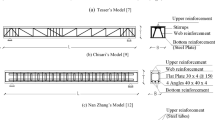Abstract
The splitting of concrete covers due to the expansive action of corrosion has been investigated by a finite element method (FEM) based on an element-embedded crack concept called the inner softening band. Fictive cross-sections, with and without transverse reinforcement, were studied. The concrete composition (plain and fibrous high-strength concrete) and the cover thickness were varied. The model produced credible fracturing behaviour in concrete covers and explained the mechanical origin of the cracks. For cover thicknesses less than two times the bar diameter, fibres do not seem to have any significant effect on occurrence of splitting cracks. However, fibres are effective to arrest the opening of arisen splitting cracks and to redistribute the strains to other cracks. Hence, fibres may postpone or prevent a total spalling of concrete covers. A larger cover is necessary not only to prolong the initiation period, but also for the fibres (2 volume-%) to be effective beyond occurrence of corrosion induced cover cracks.
Résumé
La fissuration de la couche protectrice d'une poutre en béton causée par l'expansion due à la corrosion, a été étudiée à l'aide de la méthode des éléments finis basée sur le concept de fissure élémentaire incluse, appelée bande interne de radoucissement. Des sections transversales fictives, avec et sans armatures transversales ont été étudiées. La composition du béton de haute résistance (avec et sans fibres) et l'épaisseur de la couverture des armatures ont été étudiées. Le modèle a généré un comportement crédible de la rupture dans la zone d'enrobage des armatures, permettant d'expliquer l'origine mécanique des fissures. Pour une épaisseur de recouvrement inférieure à deux fois le diamètre de l'armature, les fibres ne semblent pas avoir d'effet significatif sur l'apparition des fissures. Cependant les fibres sont efficaces pour arrêter l'ouverture de fissures existantes et pour redistribuer les contraintes aux autres fissures. Les fibres peuvent retarder ou éviter la destruction de la couche protectrice en béton de la poutre. Une épaisseur de couverture supérieure est nécessaire non seulement pour prolonger la période d'initiation mais aussi pour que les fibres (2% en volume) soient efficaces lors de l'apparition de fissures d'origine corrosive.
Similar content being viewed by others
References
Dagher, H. J. and Kulendran, S., ‘Finite element modeling of corrosion damage in concrete’,ACI Struc. J. 89 (6) (1992) 699–708.
Molina, F. J., Alonso, C. and Andrade, C., ‘Cover cracking as a function of rebar corrosion: Part 2-numerical model’,Mater. Struct. 26 (1993) 532–548.
Siewiec, P., Stroeven, P. and Moczko, A.T., ‘Study of steel bar corrosion by experimental and analytical simulation’, in ‘DIANA Computational Mechanics '94’, Proceedings of an International conference, Delft, the Netherlands, October 24–25, 1994 (Kluwer academic publishers, 1994) 383–394.
Ueda, T., Sato, Y., Kakuta, Y. and Kameya, H., ‘Analytical study on concrete cover cracking due to reinforcement corrosion’, in ‘Concrete Under Severe Conditions 2’, Proceedings of an International conference, Tromsø, Norway, June 21–24, 1998 (E & FN Spon 1998) 678–687.
Noghabai, K., ‘Splitting of Concrete in the Anchoring Zone of Deformed Bars—A Fracture Mechanics Approach’, Licentiate thesis 1995:26L (Lule⇘ University of Technology), Lule⇘, Sweden, 1995).
Noghabai, K., ‘Effect of Tension Softening on the Performance of Concrete Structures-Experimental, Computational and Analytical Studies’ Ph. D. thesis 1998:21 (Lule⇘ University of Technology, Lule⇘, Sweden, 1998).
Noghabai, K., ‘Discrete versus smeared versus element-embedded crack models on ring problem’,J. Engng. Mech., ASCE 125 (3) (1999) 307–315.
Tepfers, R., ‘A Theory of Bond Applied to Overlapped Tensile Reinforcement Splices for Deformed Bar’, Dissertation, (Chalmers University of Technology, Sweden, 1973).
Noghabai, K. ‘Environmental effects on bond in reinforced concrete structures’, in ‘Durability of Building Materials & Components 7’, Proceedings of an International Conference, Stockholm, May 1996 (E & F N Spon, 1996) 605–614.
Klisinski, M., Runesson, K. and Sture, S., ‘Finite element with inner softening band’,J. Engng. Mech., ASCE 117 (3) (1991) 575–587.
Ohlsson, U. and Olofsson, T., ‘Mixed-mode fracture and anchor bolts in concrete analysis with inner softening bands,’.J. Engng. Mech., ASCE 123 (10) (1997) 1027–1033.
Tano, R., ‘Localization Modelling with Inner Softening Band Finite Elements’ Licentiate thesis 1997:26 (Lule⇘ University of Technology, Lule⇘, Sweden, 1997).
Andrade, C., Alonso, C. and Molina, F. J., ‘Cover cracking as a function of rebar corrosion: Part 1-experimental test’,Mater. Struct. 26 (1993) 453–464.
Rodríguez, J., Ortega, L. M., García, A. M., Johansson, L. and Pettersson, K., ‘On site corrosion rate measurements in concrete structures using a device developed under the Eureka Project EU-401’, (Paper to Int. Conf. on Concrete Across Borders, 22–25 June, 1993, Odense, Denmark) Teknisk Verksamhetsberättelse 1993/1994 (CIB, Sweden, 1994).
Rodríguez, J., Ortega, L. M. and Casal, J., ‘Corrosion of reinforcing bars and service life of reinforced concrete structures: Corrosion and bond deterioration’, in ‘Concrete Across Borders’, Proceedings of an International Conference, Odense, Denmark, June 22–25, 1993, (1994).
Author information
Authors and Affiliations
Rights and permissions
About this article
Cite this article
Noghabai, K. FE-Modelling of cover splitting due to corrosion by use of inner softening band. Mat. Struct. 32, 486–491 (1999). https://doi.org/10.1007/BF02481632
Received:
Accepted:
Issue Date:
DOI: https://doi.org/10.1007/BF02481632




